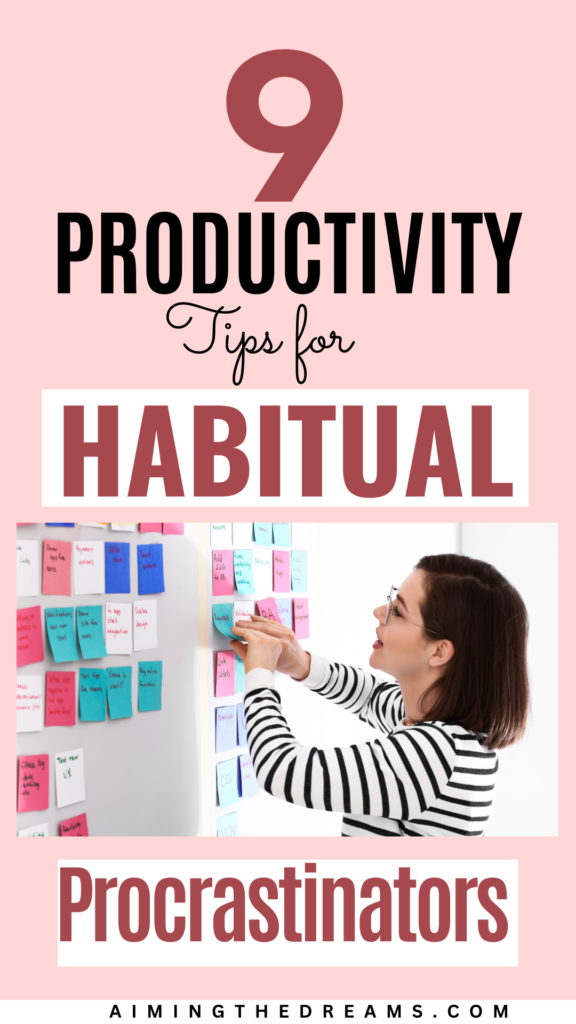Procrastination is a habit that will become chronic if you do not tame it in time. As we all know, it is challenging to break chronic bad habits. Procrastination can often feel like an insurmountable hurdle, but it’s more manageable than you might think. By adopting these productivity tips for habitual procrastinators, you can transform your approach to tasks and beat the habit of postponing.
These tips are designed to integrate seamlessly into your daily routine, providing you with the tools to tackle projects efficiently.

If you love Procrastinating and enjoy daydreaming instead of taking action, these nine tips will help you overcome procrastination.
Once your mind is geared toward focus and action, you will feel more comfortable accomplishing the tasks.
Diving into time-management strategies, setting small actionable goals, and understanding the psychology behind your procrastination are just a few methods to increase your productivity.
A clear structure for your day and accountability can go a long way in keeping procrastination at bay.
Tailoring these tips to fit your specific needs will make them even more effective, turning once daunting tasks into manageable parts of your day.
.
Productivity Tips for Habitual Procrastinators
Embracing these habits will help you complete tasks and alleviate the stress of last-minute work surges. Learning to prioritize and delegate, using technology, and allowing yourself timed breaks are essential tactics in the fight against procrastination.
Implement these systematically, and you’ll likely see a shift in your efficiency and overall work satisfaction
1. Setting Realistic Goals
Setting achievable goals is crucial for enhancing productivity. Below, discover how to effectively break down tasks and establish schedules that work for you.
Breaking Down Tasks
Start by outlining your project’s end goal. Then, create a step-by-step plan by dividing the main goal into smaller, manageable tasks.
For instance:
- Project Goal: Write an eBook on recipes.
- Task 1: Write down the topics for chapters
- Task 2: Select the chapter topic by [Date].
- Task 3: Complete the draft by [Date].
- Task 4: Complete the eBook [Date].
This method makes your goal less intimidating and easier to tackle piece by piece.
Scheduling and Deadlines
Once tasks are broken down, assign a specific deadline to each one and enter these into your calendar. Utilize tools like digital planners or apps to set reminders.
Here’s an example of how to schedule tasks:
| Task | Deadline | Reminder |
|---|---|---|
| Select topic | MM/DD/YYYY | 1 week before |
| Research notes | MM/DD/YYYY | 2 days before |
| Draft introduction | MM/DD/YYYY | 1 day before |
Ensure deadlines are sensible; allot more time for complex tasks and less for simpler ones.
Regularly review and adjust your schedule if necessary to maintain realistic expectations.
2. Prioritizing Tasks
Mastering the art of prioritizing your tasks effectively can drastically improve your productivity. This is one of the essential productivity tips for habitual procrastinators. Prioritizing tasks is the single most important habit that can help you somewhat eliminate your procrastination.
The Eisenhower Matrix and the ABC Priority Technique are potent techniques for sorting through your duties.
The Eisenhower Matrix
The Eisenhower Matrix is a decision-making tool that helps you prioritize tasks based on urgency and importance.
It’s a four-quadrant box that allows you to categorize tasks into:
- Urgent and important (Do first)
- Important, but not urgent (Schedule)
- Urgent, but not important (Delegate)
- Neither urgent nor important (Eliminate)
To use this method, list all your tasks and assign each to one of the four categories.
| Urgency / Importance | Do First | Schedule | Delegate | Eliminate |
|---|---|---|---|---|
| Urgent and Important | – Complete tax returns | – Plan family vacation | – Answer emails | – Browse social media |
| Not Urgent but Important | – Going to doctor | – Reading professional books | – Booking travel for manager | – Watching TV shows |
This visual organization empowers you to focus on urgent and essential tasks, ensuring you’re not wasting time on less critical activities.
3. ABC Priority Technique
The ABC Priority Technique involves assigning a hierarchy of importance to your tasks.
- A (Most important) – Tasks that have significant consequences if not completed.
- B (Important) – Tasks that are important but have mild consequences if delayed.
- C (least important): Tasks that would be nice to get done but have no real consequences if put off.
To implement this, list your daily tasks and mark each with an A, B, or C. Then, prioritize your day by tackling A tasks first.
Example:
- A: Prepare a presentation for tomorrow’s meeting.
- B: Reply to client emails.
- C: Organize desk drawers.
Applying the ABC Priority Technique ensures that your most critical tasks are addressed first, creating an effective workflow that combats procrastination.
4. Creating a Productive Environment
Minimizing distractions and optimizing your workspace for efficiency and comfort are essential to transforming your space into a productivity haven.
Minimizing Distractions
- Turn Off Notifications: Silence your phone and computer notifications. Use the Do Not Disturb mode during work hours.
- Use Noise-Canceling Headphones: Invest in a quality pair to block out ambient noise.
- Manage Your Environment: Keep your workspace dedicated to work. Inform those around you of your work schedule to prevent interruptions.
Optimizing Workspace
- Ergonomics: Ensure your chair and desk are at the right height. Your eyes should be level with the top third of your monitor.
- Lighting: Set up your workspace with plenty of natural light. Add a desk lamp to reduce eye strain.
- Organize: Keep your desk clutter-free. Use organizers and keep only essential items within reach( I need to learn this one).
- Personal Touches: Add a plant or a personal item that doesn’t distract but enhances your mood.

5. Time Management Strategies
Effective time management is crucial for overcoming procrastination. You can tackle tasks efficiently and enhance your productivity by applying structured techniques.
Pomodoro Technique
The Pomodoro Technique involves working in short, focused intervals called “Pomodoros,” which are traditionally 25 minutes long, followed by a 5-minute break. The Pomodoro technique has helped me immensely in controlling my procrastination habit.
It is so helpful that you will notice a change in your efficiency. It also helps decrease feeling overwhelmed when you have tasks piled up.
Here’s how to implement it:
- Choose a task to work on.
- Set a timer for 25 minutes.
- Work on the task until the timer rings, then mark down one Pomodoro.
- Take a 5-minute break.
- After four Pomodoros, take a longer break (15-30 minutes).
Time Blocking Method
The time-blocking method requires you to allocate specific blocks of time for each task or group of tasks. Follow these steps:
- Plan your day with time blocks dedicated to different activities.
- Example: 9-10 am Email, 10-12 pm Project Work
- Prioritize tasks and give each a designated time slot.
- Stick to your schedule as closely as possible, transitioning between tasks as planned.
6. Building Effective Habits
Adopting new habits is a gradual process that requires strategy and consistency.
As a chronic procrastinator, you can cultivate productivity by integrating habit stacking and making incremental improvements into your routine.
Habit Stacking
Habit stacking pairs a new habit with an existing one, creating a linked sequence of actions. Start by identifying a well-established habit in your daily routine. Then, select a productivity habit you want to develop.
- Current Habit: Checking emails in the morning
- New Habit: Spending 10 minutes planning the day
👉Your sequence might look like this: After checking your emails, spend 10 minutes planning your day’s tasks immediately. This connects your new habit to an automatic behavior, increasing the likelihood of it sticking.
Incremental Improvements
Incremental improvements involve making small, manageable changes over time rather than overhauling your routines simultaneously.
To implement this:
- Break down the productivity habit into smaller steps
- Focus on improving one step at a time
For example, if you want to write a report, start by writing one paragraph daily and gradually increase the amount as you become more comfortable with the process. This will offer a sense of progress and achievement, making the task less daunting and more approachable.
How to beat procrastination and be more productive
7. Overcoming Perfectionism
Overcoming perfectionism is crucial for chronic procrastinators.
Your productivity hinges on accepting that imperfections are part of the process and that excellence does not require perfection.
Embracing ‘Good Enough’
Recognize that ‘good enough’ is a worthy goal. Instead of aiming for perfection, focus on completing tasks effectively.
Ask yourself, “Does this meet the necessary criteria?” If the answer is yes, consider the task complete and move forward.
- Benefits of ‘Good Enough’:
- Increased productivity
- Less time spent on unnecessary details
- Greater satisfaction with completed work
Setting Achievable Standards
Raise awareness of the standards you aim for and ensure they are challenging yet attainable. Break tasks into manageable steps and set realistic timelines.
- How to Set Achievable Standards:
- Outline clear objectives for each task
- Identify the minimum requirements needed for success
- Use past experiences to inform realistic goals
8. Leveraging Technology
Harnessing the right technology can significantly enhance your productivity as a habitual procrastinator.
Productivity Apps
Productivity apps can serve as a crucial tool in managing your tasks efficiently. They offer various functionalities like task management, time tracking, and scheduling to help you stay organized and focused.
- Task Management: Use apps like Todoist or Microsoft To Do to create, categorize, and prioritize tasks.
- Time Tracking: Tools like Toggl and Clockify allow you to record how much time you spend on different activities, which can help identify time-wasting habits.
Website Blockers
Website blockers are essential for minimizing distractions that contribute to procrastination. They restrict access to websites that commonly disrupt your focus during work hours.
- Cold Turkey and Freedom are examples of software that can block distracting websites across various devices.
- Set specific times or create schedules within these apps to automatically initiate website blocking, ensuring you remain on task without manual intervention.

9. Seeking External Accountability
Creating a system of external accountability can significantly enhance productivity. You can pressure yourself to meet your commitments by involving others in your goals.
Accountability Partners
Choose someone you trust to be your Accountability Partner. This person should be reliable and willing to check in with you regularly on your progress.
Here’s how to structure this relationship:
- Set clear expectations with your partner regarding check-ins.
- Share your goals and the steps you intend to take.
- Schedule regular update sessions to report on your progress.
Utilize tools like shared calendars or task management apps to help you keep track of your commitments.
Public Commitments
Making your goals public increases your sense of responsibility to follow through. Here’s how to effectively leverage public commitments:
- Declare your objectives on social media or blog posts.
- Join online groups or forums where members hold each other accountable.
- Update your progress publicly to maintain a record of your journey.
Remember, the fear of public failure can be a powerful motivator to keep you on track.
